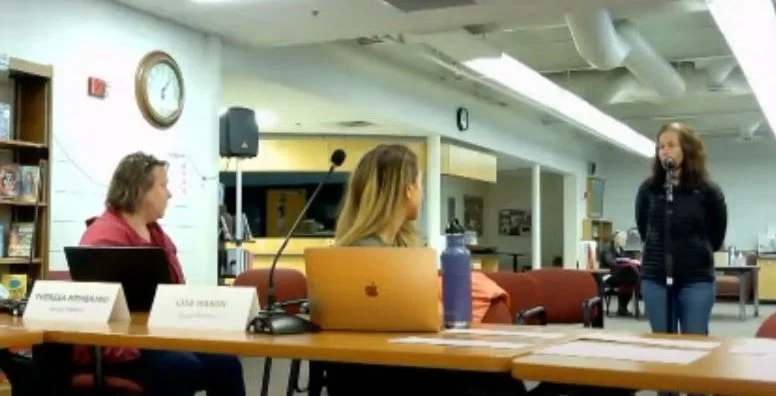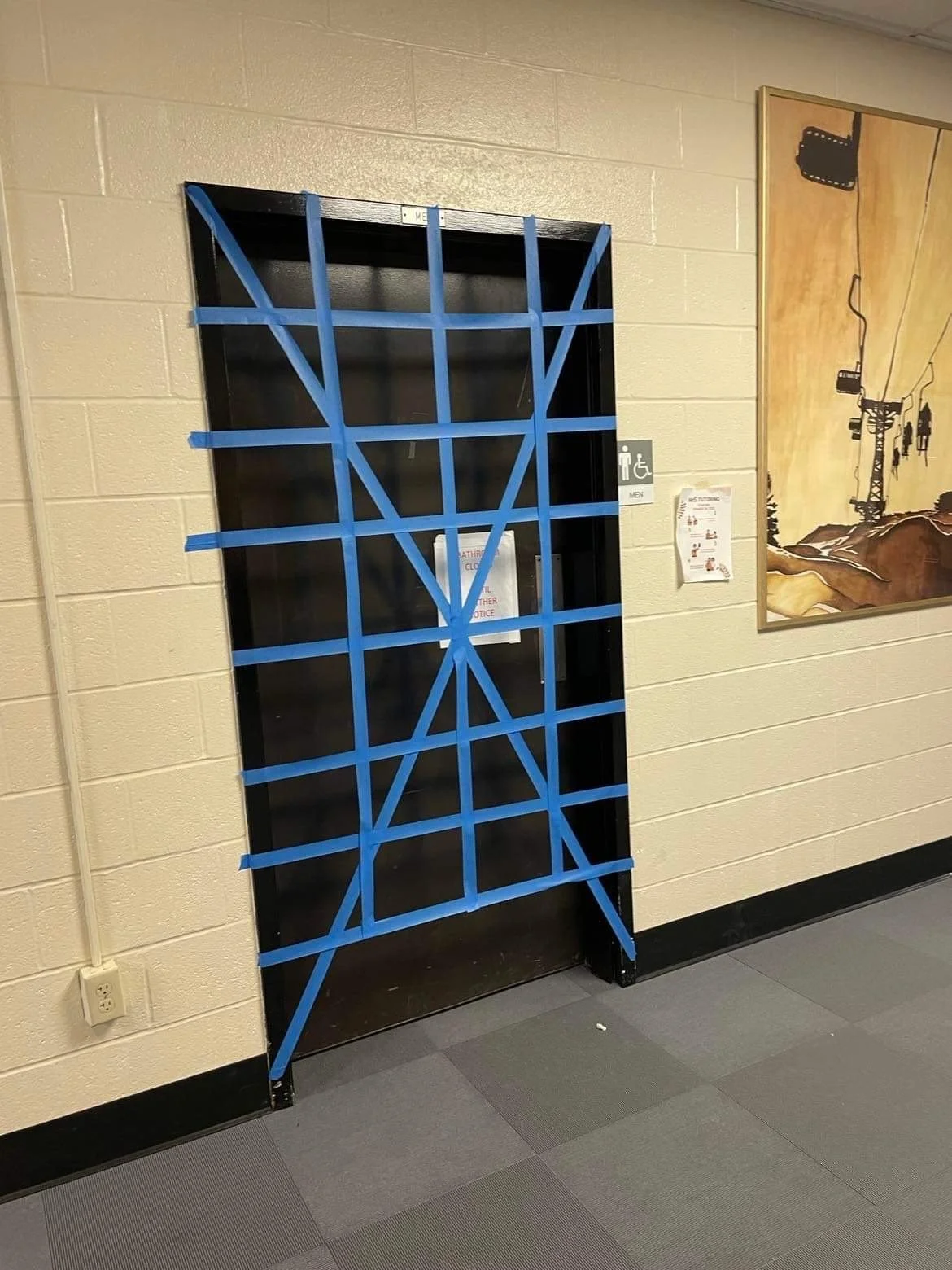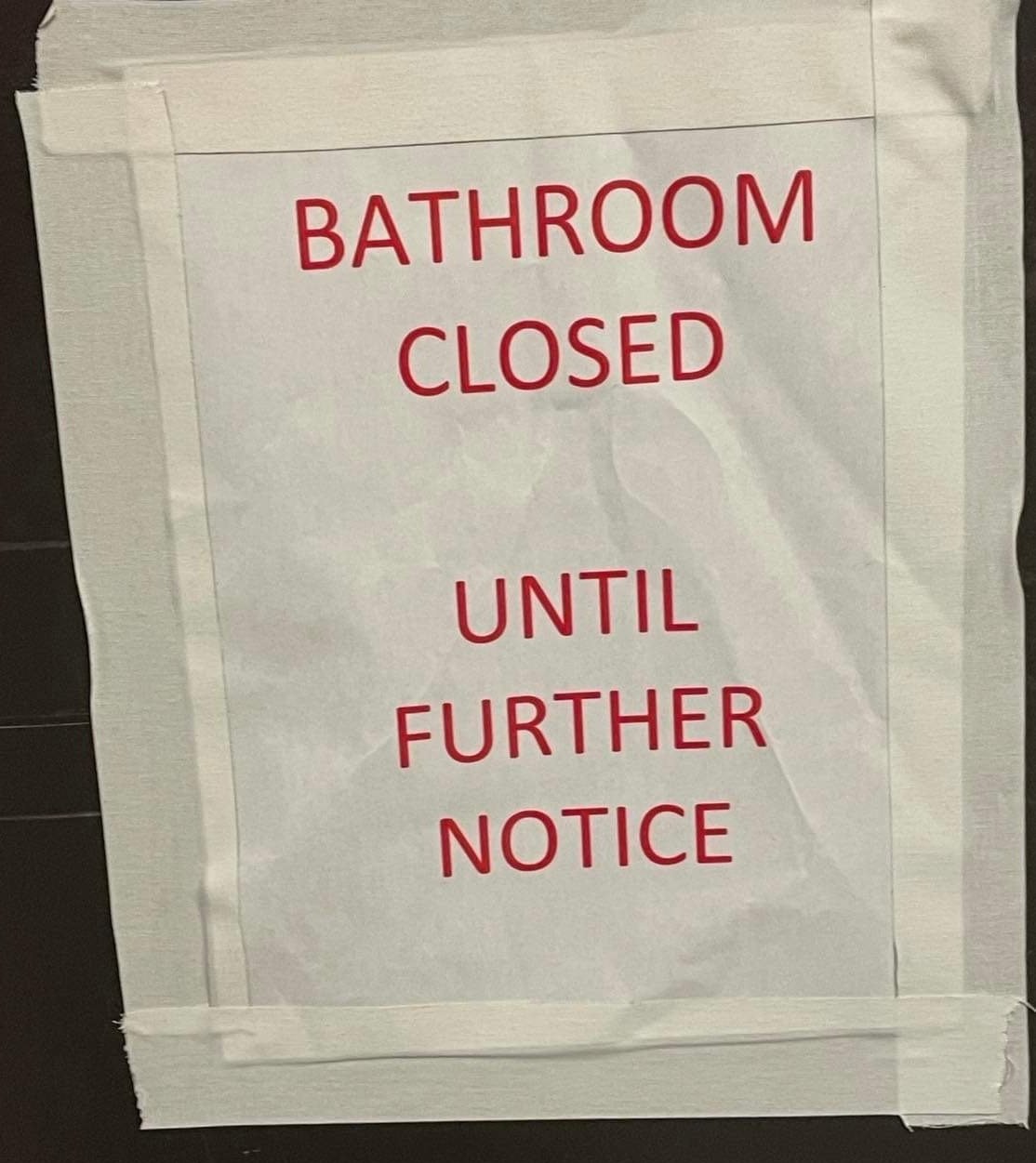Harwood Union HS grapples with vandalism, vaping, violence
April 6, 2022 | By Lisa ScagliottiUPDATE: This story has been updated on April 9 with a response from Superintendent Brigid Nease and a clarification on a proposal for a new position paid for with federal ESSER III funding.
* * * * * * * * * *
Over the course of this school year and particularly in recent weeks, student safety has become a paramount issue at Harwood Union High School.
That became apparent in the opening minutes of the newly reorganized Harwood Unified Union School District School Board’s March 23 meeting.
During just three minutes of public comment, parent Michele Ritzinger, of Fayston, summed up her family’s recent experience and called for adults in the school district to do more in response.
She told of how on Feb. 1 her son was attacked by three other students in a boys bathroom.
Parent Michele Ritzinger addresses the HUUSD School Board on March 23. Board members Theresa Membrino of Fayston (left) and Lisa Mason of Moretown (center) listen. Screenshot
“My concern is the safety of the school and the safety of the other students. I have nothing personal against the principals, I just feel that they did not handle the situation well enough, quickly enough. I just feel that they didn't respond in the way that I felt they should have responded,” Ritzinger told the school board.
“I do not feel that my son had enough of a voice in what happened to him. I feel that they chose to believe the other boys over him because there were three of them and they had a different story than he had,” she continued. “I feel like he got lost in that in the shuffle of assault.”
Ritzinger was the lone individual to address the school board that night. In keeping with the board’s rules, her time to speak was limited to three minutes. Most of the 11 members of the board were present in person.
Ritzinger told how her son since had been uncomfortable attending school, how he’s been subject to “lashing out” from the students involved in the assault and their friends. “He’s had food thrown at him, and he and I have been so concerned that I had stalking orders issued on these three boys,” she explained. “I've been told that that's hard to do, so obviously the judge feels that there's a need for that.”
Ritzinger said administrators have not answered her inquiries about consequences for the perpetrators. “As the victim's mother, I feel that I should be able to know that kind of stuff,” she said.
She commended her son’s teachers and friends who have been supportive in the weeks following the incident. Acknowledging that details of her son’s case would be confidential because they involve minors, she stressed that she expected more of a response from school administration about overall school safety.
“I really feel like they just need to stand up more and be the principals and do what's right and guide the school and guide the students. That's our job as adults and I feel that's the job of the principals, and I just - I just feel like it didn't happen,” Ritzinger said.
School board members listened attentively as Ritzinger spoke and adhered to their meeting rule of not responding to public comments. None offered any reaction when Ritzinger finished.
The meeting was the first for Moretown representative Kristen Rodgers as chair. “Thank you,” she said to Ritzinger, then proceeded to move into the meeting agenda.
Issues mount
In the days since the assault on Ritzinger’s son, there has been a measured response from school leaders.
Although they have not accepted requests for interviews, school co-principals Laurie Greenberg and Megan McDonough have communicated via email and school online newsletters with parents, staff and reporters. They explain they cannot discuss the assault or consequences for those involved. They point to school bullying policy that guides school action and said they would turn to law enforcement when necessary.
A slide from a student presentation to the school board last fall. Screenshot (click to enlarge)
The most concrete steps to address the safety issue came in mid-March when staff and students launched a school-wide effort that had been in the works since last fall to conduct student-led discussion groups.
Student facilitators last fall began working to train a team of some 50 students who would lead discussions in their TA groups – short for “Teaching Advisory” which are the classes students are assigned to where they begin each day, essentially a homeroom/home base setting for their four years of high school. At the time, the effort was aimed at issues around vandalism happening in school bathrooms and growing concern about vaping.
The vandalism began early in the school year as a social media challenge spread across the country including Vermont where students damaged or stole items from school buildings and then boasted about their exploits on Tik Tok and Snapchat. Harwood had its share of incidents that persisted prompting the closure of multiple restrooms around the building due to damaged fixtures and plumbing.
An opinion piece published in the school’s online student newspaper Common Ground in early December added vaping to the community discussion. With the headline “Harwood Bathrooms: A Shameful Experience,” the piece begins with the statement that, “Vandalism continues in the school’s bathrooms; students vaping and writing obscenities persist.”
Bathrooms closed due to damage were a problem. “The disrespect and destruction of school property is obnoxious,” student authors Nicholous Lord and Carly Young write.
They conclude by saying: “Overall, the behavior in the bathrooms at this high school is unacceptable and plain disappointing. Everybody needs to use the bathroom from time to time, and when the restroom itself becomes an unsafe place to use, only more problems can come of it as a result.”
By January, an email from the school principals to students said boys bathrooms remained closed except for a small bathroom near the cafeteria with paper towels available outside the space “to address the inappropriate use of them to clog the toilets.”
They said “vandalism and destruction in our boy's bathrooms continues to increase.” They listed impacts as “1. great disrespect to our custodial staff, 2. cost of repairs, 3. impact on our sewage system and health concerns that must be mitigated.”
One of the school bathrooms that were closed earlier this year. Provided photo
Bathroom door sign closeup. Provided photo
A closed school bathroom is bolted shut earlier this year. Provided photo
Police involved
The assault Ritzinger recounted happened soon after some school bathrooms reopened.
Again school principals weighed in using an email newsletter on Feb. 11.
“Maintaining a community that is safe for our community remains Harwood’s top priority,” they wrote. “While we can not share details regarding specific consequences and actions taken we want to assure families and students that we continue to actively address unsafe behaviors and create a community of high expectations for all.
Please note that not all misbehaviors fall within the ability to intervene and handle here at school. Student behaviors and/or choices that rise to a level of serious threat, damage, or harm will be dealt with swiftly up to and including loss of privileges, suspension, and involvement of law enforcement when necessary.”
A check with Vermont State Police confirmed that the Feb. 1 assault was reported to police. “But due to the ages of the people involved, we’re unable to provide any additional information,” said Vermont State Police spokesman Adam Silverman in an email to Waterbury Roundabout on Feb. 9. “For any additional information, I will need to refer you to school administrators.”
Waterbury Roundabout received a similar reply from Silverman back in November after state police were called to Harwood Union High School regarding a fight among juveniles outdoors on the school campus after school while a fall soccer playoff game was being held. Reports of an assault in that situation could not be confirmed by police and school administrators would not comment.
School principals in their Feb. 11 message to parents suggested discussing social media use with their children and “promoting kindness and care by speaking up when something unsafe is seen.”
They also announced that the student led discussion groups would soon be set into motion.
Talking it out
Those discussions took place soon after students returned from February break. A few minutes after Ritzinger spoke at the March 23 school board meeting, senior Maisie Franke reported on the student-facilitated conversations.
“Last Wednesday… we had every single student in the building sitting in a circle conversation being led by one of their peers,” she said. “They were centered around school safety and how students feel at Harwood since this was the topic that seemed most relevant to us and something that we needed to discuss as a community.”
A teacher in each room took notes, Franke explained. The conclusions?
“Overall students feel that for some, Harwood feels like a safe place, but they know that for others, it doesn't feel that way. And that was a trend that came up in almost all the conversations of the recognition that even though I might feel safe - or even though others might feel safe - that's not the case for everyone,” she said.
Two key points emerged, she continued.
Slide from student presentation to the school board on March 23. Screenshot. (click to enlarge)
“One, [a need for] safe student spaces where students can go to either get support or report incidents, or have a place where teachers are easily able to be reached and they can either go for a mental break and recharge or just mainly to get support for all types of things,” she described.
“And the second thing that was came up a ton was teachers an admin need to really be enforcing rules and be direct about consequences -- really clear communication and follow through, since that was a part that we seem to lack. And that even though those are communicated, we don't often see the follow-through on it.”
Franke said notes from all of the discussion groups would be compiled and somehow shared with students, teachers and the community in general.
‘The best intentions’
On March 25, school principals in the latest Family Newsletter thanked student discussion leaders and reiterated the key points that Franke described to the school board.
The principals then note how future action around the issue needs to be a group effort.
“Harwood students and staff moving forward need to strive to speak up and be advocates for others, collaborate with one another to create solutions, and be strong to our values as a community,” they wrote. “Everyone of us holds the best intentions of making Harwood a safer place for all students and we will get there through direct communication on next steps and transparency on what we need to be able to learn and succeed in our school.”
Some other efforts underway that may play a role in making improvements include a district-wide online climate survey asking students from grades 3 and up and parents of all students to answer questions about the climate in their child’s school. The school district has contracted with an outside firm to collect the responses and produce a report with results to be shared later this year.
Also on the horizon at Harwood may be possible federal funding for staff positions whose roles may be aimed at working with students to confront some of the issues that have vexed the high school this year.
In a presentation to the school board on Feb. 9, Director of Curriculum and Technology Shannon Lessley outlined how school administrators plan to spend $3.1 million in the latest round of federal emergency relief funds coming to the district. The plan aims to continue funding many items earlier rounds of federal relief money paid for.
Among some new items Lessley pointed out is a recommendation to hire a “wellness and restorative consultant” who could “come into the high school and work with us for the next couple of years to help bring some best practices to the faculty and to the students to help with some of those behaviors and other things they’re seeing at the high school.” A link to details regarding federal ESSER funds including a feedback form for the latest ESSER III round are on the HUUSD.org homepage.
Reached this week, Ritzinger reflected on the past two months. She said she has not heard from school officials since her brief appearance before the school board and although she appreciates the process to involve students, she’s not convinced it’s enough.
“It’s great that the students are able to have their voices heard,” she said. “I’m just a little confused about the whole situation. I always thought it was the principal’s job to keep things in line, to keep things safe.”
Superintendent responds
On Friday, April 8, Superintendent Brigid Nease released her report to the HUUSD School Board ahead of its meeting April 13. She devotes nearly four pages to the section titled “Behavior, Discipline and Harwood Union High School” where she addresses the Feb. 1 assault, the administration’s handling of it, and calls for more information and action in its wake.
Waterbury Roundabout has published Nease’s response in full in the Opinion section.
Her conclusion addresses the incident and the action taken out of public view. She stresses that the high school at present is safe and the district aims to improve the “climate and culture” in all of its schools. She states:
“Harwood Union has experienced some challenging and harmful behaviors by a small number of students. Those incidents are taken seriously and dealt with swiftly, appropriately, and confidentially with the students involved and their families. No one is minimizing the seriousness of these unfortunate, harmful incidents, least of all the administration. The discipline issued and the manner in which a harmful incident is dealt with in a public school can vary greatly from what parents may choose to do in their own family. Notwithstanding these challenges, overall our Harwood Union High School is safe…and we will continue to strive to improve climate and culture in all HUUSD schools.”
* * * * * * * * * *
Ritzinger’s comments are recorded in the draft March 23 school board meeting minutes with one sentence saying she “commented on a recent student safety incident at Harwood Union.” The school board’s own summary of the meeting that it posts online and circulates to schools for their newsletters makes no mention of her addressing the board.
A recording of the meeting is available to watch on the school’s YouTube channel that’s available on the HUUSD.org website under the Board heading and also on MadRiverTV.com.
Related stories:




